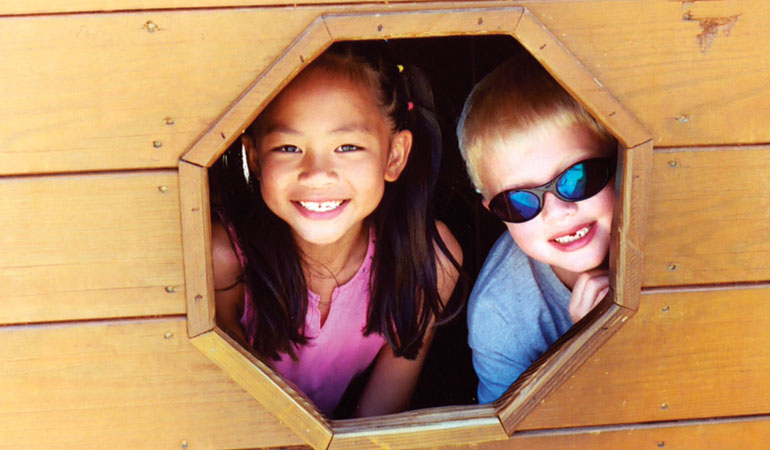Deidre and Brad Sassaman often tell their children, “We are an Irish-German-Chinese family.” The Irish comes from Deirdre’s heritage, the German from Brad’s, and the Chinese from daughter May, adopted a few years ago.
It’s not unusual to see May in a green T-shirt that reads, “I’m an Irish princess,” or for Kevin, who is five, to proudly wear his Chinese outfit, especially when the family celebrates Chinese New Year. This time around, however, Ryan wants no part of Chinese outfits. That’s OK, too. He’s 16.
In families where children arrive both by birth and by cross-cultural adoption, there’s not just a new person in the family, there’s also a new culture. That means there are adjustments to be made, both inside the family and in the community. Here’s how to help kids face the world — and each other:
Outside the Family
1. Be ready to lose some privacy. “When you’re in public, you don’t get to pick and choose what you want to reveal to others,” says Kim Stevens, a former director of Massachusetts for Families, an adoption and foster-care training program in Roxbury. “I knew we would draw attention after adopting May,” says Deidre Sassaman.
2. Prepare kids for comments. Talk about what your children are likely to hear when a sibling of a different race arrives, says Deborah Johnson, executive director of the Minnesota Adoption Resource Network and a specialist in transracial adoption. Don’t let your children be taken by surprise. Be open about the choices you have made and the values your family espouses.
Gretchen and Paul Felopulos of Natick, Massachusetts, began having simple conversations about differences with Chloe long before they adopted Phoebe. Good thing, too. Soon after Phoebe arrived, when a playmate insisted, “She’s not your real sister!” Chloe was incensed, but prepared. “She is so my real sister!” she said. “She’s my forever sister!”
3. Tell kids the truth. “As uncomfortable as it may be for you, don’t sugar-coat,” says Johnson. “It’s classic for parents to say, ‘Those people were staring because you and your sister are so cute.’ No, they were staring because you’re different. Say so: ‘They were staring because our family is different. We see each other every day, so we don’t notice our differences so much. But other people do.'”
4. Demonstrate good responses. Children in transracial families fare best when parents illustrate a range of reactions, depending on the circumstances. If someone asks, “Is she adopted?” it may be a genuine, albeit stupid, question. Part of your job is to teach a life skill: How to evaluate people’s motives.
Is this person sincere or merely rude, clueless or prejudiced? What is the tone? What is the body language? If someone is rude, it may be appropriate to turn your back, walk away, and then talk to your child. If a question is sincere, but misguided or inappropriate, you might say, “This isn’t a good place to talk. If you’re interested in adoption, I’m happy to have you call me.”
Children also need to know that their mood counts. Sometimes, a question isn’t an invasion of privacy, it’s just poorly timed. “’I’m not in the mood to talk about it’ is a perfectly fine answer,” Johnson says.
If children five or older start to hate the attention, humor may the best antidote — when someone asks a silly question, roll your eyes at each other, or make a joke.
5. Stand up for the ignored sibling. When someone oohs and aahs over May, Deidre Sassaman is quick to say, “My daughter, May is very beautiful and smart. So is my son, Kevin.” But the comments are constant, and she can see that they get to Kevin. Once, when a stranger approached the family and asked May, “What’s your name?” Kevin gave his name, only to realize, from the person’s reaction, that she wasn’t interested in him. Deidre felt as if he were shrinking.
At Home
1. Address favoritism concerns. With all siblings, feelings of filial loyalty come and go. For kids in blended families, there are added layers. If your child who was adopted came into the family first, she may think, “They’ll love this baby more because it looks like them.”
Address fears even if they don’t get verbalized, advises Johnson. Say, “Some people may wonder if we’ll love a biological child more because she looks like us. We love each other because we are a family, not because of how we look.” If your biological child came into the family first, he may resent the attention the new child gets. You might want to reassure him, “Some people may make a bigger fuss over your sister because she’s from another country. We value everybody in this family, no matter where they’re from.”
2. Celebrate everyone’s heritage. You want everyone to feel proud of their background. Just remember to keep things in balance, and be aware that siblings can reach a saturation point: “I’m not Korean. Why do I have to care about Korean history and culture?”
Flexibility and balance are key, counsels Ellen Glazer, a social worker in Newton, Massachusetts, who specializes in infertility and adoption. She suggests treating Chinese New Year the same way you would Thanksgiving. Say, for example: “This is something we do as a family.”
On the other hand, a nine-year-old shouldn’t be made to feel like she’s a terrible person because she’d rather spend the day at a friend’s birthday party than on a family outing for dim sum in Chinatown.
While some older children are enthusiastic about activities to celebrate a younger child’s heritage, others are resentful. In a twist on this theme, reader Susan Goodrich reports telling her daughter, Grace (adopted from China), that the family was planning a heritage trip to Ireland. “But I’m not Irish,” Grace said. Susan responded, “Ireland is part of our family’s heritage, the same way that China is.”
3. Nip mean behavior in the bud. “When siblings fight, they sometimes hit below the belt,” says Johnson. If you overhear a racist comment, take the offender aside and say: “Those words are not part of our family’s values.” Tell the offended party, “Your brother says he was joking, but it’s no joke to me. I’m going to be paying more careful attention.”
If you’re afraid the behavior continues in your absence, you may say to each of your children, separately, “Brothers and sisters sometimes say mean things to each other when Mom and Dad are not around. I’m not aware of that happening in our family. Is it? Am I out of touch?”
By the same token, don’t allow an aggressive younger sibling to physically hurt an older child who may not feel entitled to defend herself. And be vigilant in protecting an older child from relatives who may favor the younger, adopted sibling.
Deirdre Sassaman knows of only one blowup so far. After May had been in the family four months, she and Kevin were fighting over a toy. Kevin shouted, “I wish you would go back to China!” After Deirdre put Kevin in a time-out, she told him, “I would be very upset if either of you went away. No matter how you came into this family, you’re loved just the same.”



